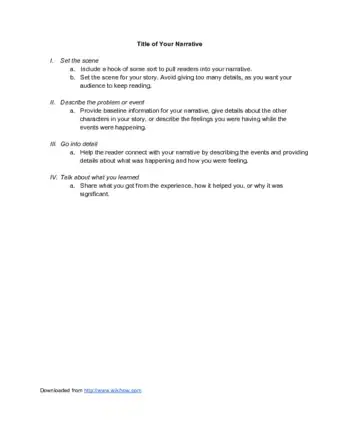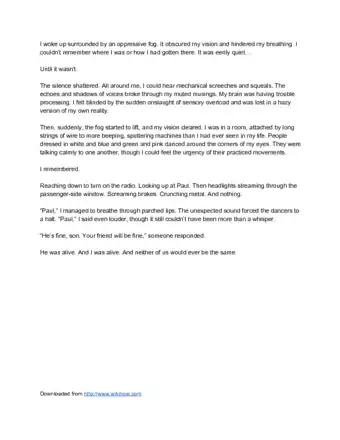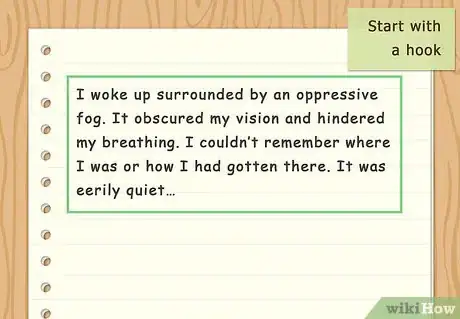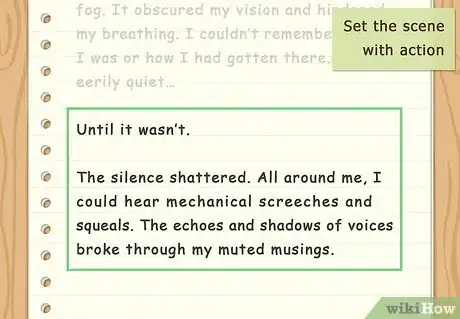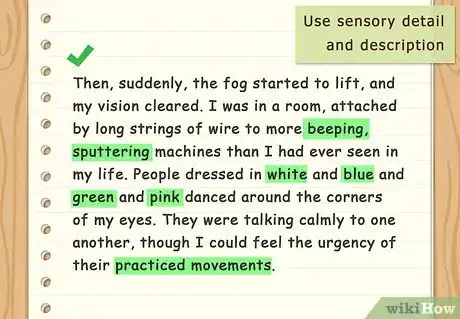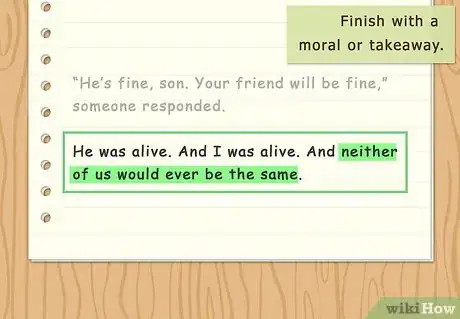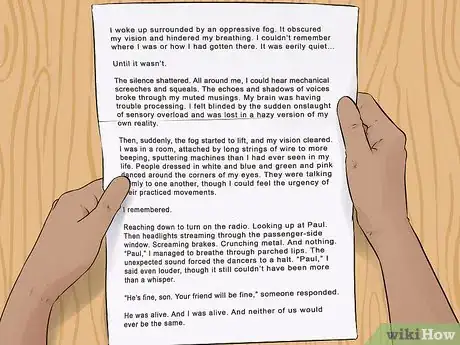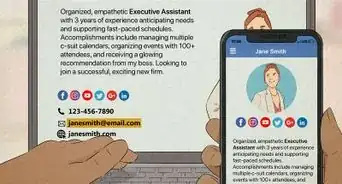This article was co-authored by Grant Faulkner, MA. Grant Faulkner is the Executive Director of National Novel Writing Month (NaNoWriMo) and the co-founder of 100 Word Story, a literary magazine. Grant has published two books on writing and has been published in The New York Times and Writer’s Digest. He co-hosts Write-minded, a weekly podcast on writing and publishing, and has a M.A. in Creative Writing from San Francisco State University.
There are 8 references cited in this article, which can be found at the bottom of the page.
wikiHow marks an article as reader-approved once it receives enough positive feedback. In this case, several readers have written to tell us that this article was helpful to them, earning it our reader-approved status.
This article has been viewed 837,627 times.
Personal narratives focus on a particular real life event that was pivotal or important for the writer. You may have to write a personal narrative as part of a college application or as an assignment for a class. To write a strong personal narrative, start by coming up with an engaging idea. Then, write the narrative with an opening hook and a detailed, organized structure. Always review and revise the personal narrative before handing it in so it is at its best.
Steps
Template and Sample Narrative
Brainstorming Ideas for the Narrative
-
1Focus on a memorable event or moment in your life. The personal narrative should focus on a specific event or moment that was memorable or made a big impression on you. It does not need to be a major moment as long as it feels memorable and important to you. The event could have seemed minor at the time but ended up being life changing for you.[1]
- For example, you may write about your struggles with body image in high school and how you overcame them in adulthood. Or you may write about your disastrous 15th birthday party and how it affected your relationship with your mother.
-
2Expand on an important conflict in your life. Personal conflict can be great fodder for a personal narrative. Think about any strained relationships in your life or any moments of major conflict that you have experienced. Explore the conflict in detail in the narrative.[2]
- For example, you write a personal narrative about your complicated relationship with your birth mother. Or you may write about a conflict you have with a sport you play or a club you are a part of.
Advertisement -
3Think about a particular theme or idea. Use a theme as a jumping off point for the narrative. Explore a theme or idea from your perspective. Consider how the theme applies to your life and your experiences thus far. Themes like poverty, isolation, sacrifice, and talent are all good options for a personal narrative.[3]
- For example, you may explore a theme like poverty by writing about your family’s struggle with money and finances. You may write about having to defer college applications to work at your parent’s business to make ends meet for your family.
-
4Read examples of personal narrative. Learn from good examples of the genre online and in print. Search for the top personal narratives online to see what a successful narrative looks like. Read and learn from these examples. You may read:
- The Boys of My Youth by Jo Ann Beard
- Slouching Towards Bethlehem by Joan Didion
- Me Talk Pretty One Day by David Sedaris
- The Lives section of The New York Times
Writing the Personal Narrative
-
1Start with a hook. Begin the personal narrative by drawing the reader in with a strong opening sentence. Use rich description and detail in the opening. Start in action so the reader is grabbed right away and keeps reading.[4]
- For example, the first line in the personal narrative by Tony Gervino is attention grabbing: “I was 6 when my brother John leaned across the kitchen table and casually whispered that he had killed Santa Claus.”[5]
-
2Set the scene with action. Ground the reader in the story by providing information on the main characters and the central conflict or theme. Tell the reader where the narrative is taking place and when it is taking place. Explain whether the story is about you and/or you and your relationship with someone else in your life.
- For example, in Tony Gervino’s essay, he sets the scene by providing setting, character, and narrative voice: “It was July 1973, we were living in Scarsdale, N.Y., and he was four years older than I was, although that seemed like decades.”
-
3Move chronologically through the events. Do not jump to different moments in time or move from a past event to a present event and then back again in the same paragraph. Go chronologically from event to event or moment to moment. This will make it easier for the reader to follow along with the narrative.[6]
- For example, you may start with an event in childhood with your older sister and then move forward in time to the present day, focusing on you and your older sister as adults.
-
4Use sensory detail and description. Focus on how things smelled, sounded, tasted, felt, and looked in the scene. Paint a vivid picture for the reader so they feel immersed in the narrative. Try to describe moments in the narrative based on the speaker’s perspective.[7]
- For example, you may describe the feeling of your mother’s famous lemon cake as “rich and zesty, with a special ingredient that to this day, I cannot identify.”
-
5Finish with a moral or takeaway. Most personal narratives end with a reflection or analysis of the events. You may come up with a moral that you share with the reader based on your own experiences. Or you may leave the reader with a takeaway thought that illustrates what you learned from your experiences.[8]
- For example, you may end a personal narrative about your complicated relationship with your troubled sister by ending on a recent memory where you both enjoyed each other’s company. You may leave the reader with a lesson you have learned about loving someone, even with all their messiness and baggage.
Polishing the Personal Narrative
-
1Read the narrative out loud. Once you have finished a draft of the personal narrative, read it aloud to yourself. Listen to how the narrative sounds out loud. Notice if there are any awkward moments or unclear sentences. Circle or underline them so you can revise them later.[9]
- You can also try reading the narrative out loud to someone else so they can hear how it sounds. This can then make it easier for them to give you feedback.
-
2Show the narrative to others. Ask a friend, peer, classmate, or family member to read the narrative. Pose questions to them about the style, tone, and flow of the narrative. Ask them if the narrative feels personal, detailed, and engaging.[10]
- Be willing to accept feedback from others. Be open to constructive criticism as it will likely strengthen the narrative.
-
3Revise the narrative for clarity and length. Read over the narrative for any spelling, grammar, or punctuation errors. Review the narrative to make sure it is not too long, as personal narratives are usually short, no more than one to five pages long. You may also need to meet a specific length requirement if you are writing the personal narrative for a class.[11]
Community Q&A
-
QuestionHow do I add detail? I'm not very good at that.
 Community AnswerTake a sentence and say to yourself: Okay, how do I make this longer? For example: "The boy ran." Then add more detail to make a mental picture. Is he tall? Is he wearing an odd hat? Is he running slow? Is he sprinting? Is he a neighbor? Is he barefoot? Is he chasing the mailman? Does he have a name? Is he being followed by anyone? Is he holding anything? Then it becomes: "The tall, white, Jewish boy who lives down the street raced by my house at top speed with a thick, white envelope in his hand -- wearing only one bright red sneaker and a black sock -- while yelling for the mailman to stop.
Community AnswerTake a sentence and say to yourself: Okay, how do I make this longer? For example: "The boy ran." Then add more detail to make a mental picture. Is he tall? Is he wearing an odd hat? Is he running slow? Is he sprinting? Is he a neighbor? Is he barefoot? Is he chasing the mailman? Does he have a name? Is he being followed by anyone? Is he holding anything? Then it becomes: "The tall, white, Jewish boy who lives down the street raced by my house at top speed with a thick, white envelope in his hand -- wearing only one bright red sneaker and a black sock -- while yelling for the mailman to stop. -
QuestionHow do I write a personal narrative for a day I will never forget?
 Community AnswerConsider why you won't forget the event. From there you should portray yourself in a way that gets the reader to believe that you won't forget this while they are in the process of reading. Give the reader reasons to see the event in the same way that you do.
Community AnswerConsider why you won't forget the event. From there you should portray yourself in a way that gets the reader to believe that you won't forget this while they are in the process of reading. Give the reader reasons to see the event in the same way that you do. -
QuestionIn my class we are supposed to write figurative language and imagery. How can I use them?
 Community AnswerFigurative language can be used in a variety of circumstances, and imagery is mainly used to describe the setting, characters and other details in a text.
Community AnswerFigurative language can be used in a variety of circumstances, and imagery is mainly used to describe the setting, characters and other details in a text.
References
- ↑ https://www.indeed.com/career-advice/career-development/personal-narrative-examples
- ↑ http://www.byrdseed.com/writing-better-personal-narratives/
- ↑ http://www.byrdseed.com/writing-better-personal-narratives/
- ↑ https://grammar.yourdictionary.com/grammar-rules-and-tips/tips-for-writing-a-personal-narrative-essay.html
- ↑ http://www.nytimes.com/2011/07/17/magazine/lives-a-rats-tale.html
- ↑ https://open.lib.umn.edu/writingforsuccess/chapter/10-1-narration/
- ↑ http://grammar.yourdictionary.com/grammar-rules-and-tips/tips-for-writing-a-personal-narrative-essay.html
- ↑ https://grammar.yourdictionary.com/grammar-rules-and-tips/tips-for-writing-a-personal-narrative-essay.html
- ↑ https://writingcenter.unc.edu/tips-and-tools/reading-aloud/
About This Article
To write a personal narrative, start by choosing a memorable moment, event, or conflict in your life that you want to write about. Then, use your personal narrative to describe your story, going chronologically through the events. Try to use a lot of sensory detail, like how things smelled, sounded, felt, and looked, so your readers can picture everything you're describing. At the end of your narrative, include a lesson you learned or something you took away from the experience. To learn how to brainstorm ideas for your personal narrative, read on!
